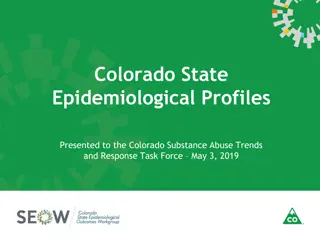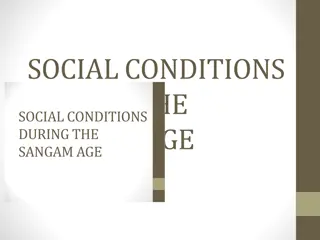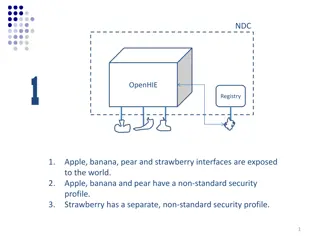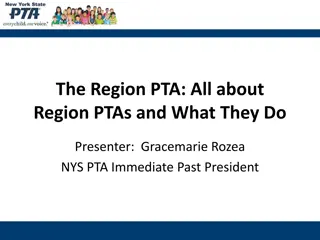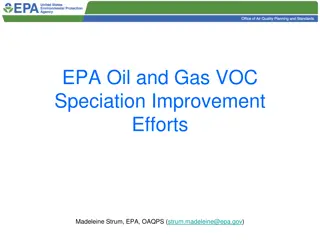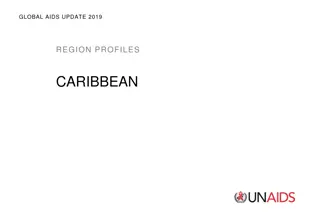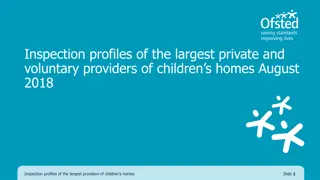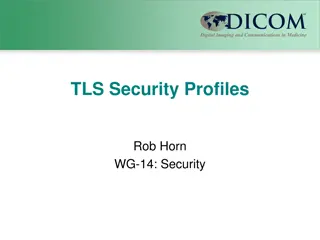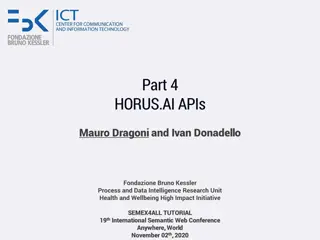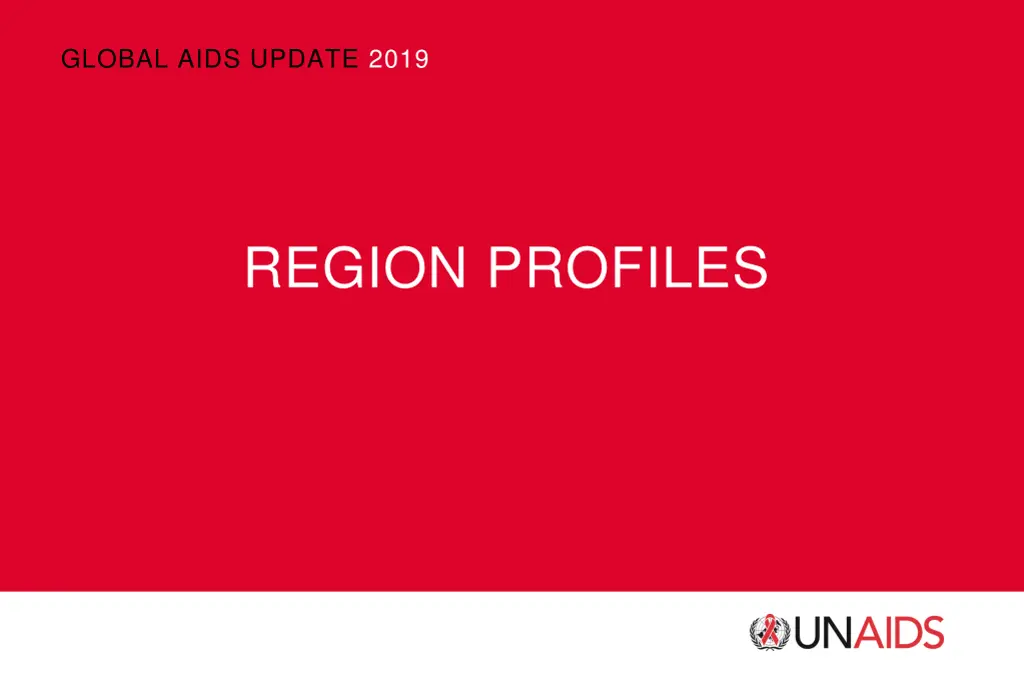
HIV Statistics in Eastern and Southern Africa
Explore the latest updates on HIV/AIDS in Eastern and Southern Africa, including antiretroviral therapy coverage, AIDS-related mortality, new HIV infections, and prevalence among key populations. Gain insights into the progress and challenges faced in combating HIV in the region.
Uploaded on | 2 Views
Download Presentation

Please find below an Image/Link to download the presentation.
The content on the website is provided AS IS for your information and personal use only. It may not be sold, licensed, or shared on other websites without obtaining consent from the author. If you encounter any issues during the download, it is possible that the publisher has removed the file from their server.
You are allowed to download the files provided on this website for personal or commercial use, subject to the condition that they are used lawfully. All files are the property of their respective owners.
The content on the website is provided AS IS for your information and personal use only. It may not be sold, licensed, or shared on other websites without obtaining consent from the author.
E N D
Presentation Transcript
GLOBAL AIDS UPDATE 2019 REGION PROFILES
GLOBAL AIDS UPDATE 2019 REGION PROFILES EASTERN AND SOUTHERN AFRICA
Antiretroviral therapy coverage and AIDS- related mortality among people living with HIV, eastern and southern Africa 300 Lesotho Antiretroviral therapy coverage: 75% and above 55 74% 250 30 54% Less than 30% Eswatini Note: Size of bubble is proportional to size of population of people living with HIV. Botswana 200 Mozambique AIDS-related mortality (per 100 000) 150 Zimbabwe South Africa Namibia 100 Zambia South Sudan Malawi Uganda Kenya 50 Mauritius Angola United Republic of Tanzania Rwanda Ethiopia Eritrea Comoros Madagascar 0 0 10 20 30 40 50 60 70 80 90 100 Source: UNAIDS 2019 estimates. People living with HIV receiving antiretroviral treatment (%)
Number of new HIV infections and AIDS-related deaths, and incidence-prevalence ratio eastern and southern Africa, 2000 2018 New HIV infections AIDS-related deaths Incidence-prevalence ratio 14 1 400 000 2 500 000 Percentage change in new HIV infections since 2010 -28% Percentage change in AIDS- related deaths since 2010 -44% 2018 Number of AIDS-related deaths Number of new HIV infections 12 1 200 000 Incidence- prevalence Incidence-prevalence ratio 2 000 000 10 1 000 000 ratio 8 800 000 1 500 000 3.9% [3.0 5.1%] 600 000 6 1 000 000 4 400 000 3 2 500 000 200 000 0 0 0 2000 2010 2018 2000 2010 2018 2000 2005 2010 2015 2018 New HIV infections AIDS-related deaths Incidence-prevalence ratio Target value Source: UNAIDS 2019 estimates.
Percentage change in new HIV infections, by country, eastern and southern Africa, 2010 2018 250 193 200 150 100 Per cent 50 35 6 0 -7 -7 -13 -13 -23 -29 -30 -30 -31 -34 -36 -50 -38 -38 -40 -43 -61 -67 -100 Botswana Uganda Mauritius Eritrea Malawi Comoros Kenya South Africa Lesotho Mozambique South Sudan Ethiopia Angola Rwanda Zambia Eswatini United Republic of Tanzania Madagascar Zimbabwe Namibia Source: UNAIDS 2019 estimates.
HIV prevalence among key populations Distribution of new HIV infections (aged 15 49 years), by population group Eastern and southern Africa, 2014 2018 Eastern and southern Africa, 2018 Sex workers 3% 90 80 70 60 50 40 30 20 10 0 People who inject drugs 8% Gay men and other men who have sex with men 4% Per cent 40.7 Remaining population 75% Clients of sex workers and sex partners of other keypopulations 10% 28.4 16.7 15.2 13.7 Sex workers, n = 19 Gay men and other men who have sex with men, n = 12 People who inject drugs, n = 6 Transgender people, n = 1 Prisoners, n = 14 Source: UNAIDS Global AIDS Monitoring, 2014 2018. Source: UNAIDS special analysis, 2019.
Estimated size of key populations, eastern and southern Africa, 2018 Country National adult population (15+) Sex workers Sex workers as per cent of adult population (15+) Gay men and other men who have sex with men Gay men and other men who have sex with men as per cent of adult population (15+) People who inject drugs People who inject drugs as per cent of adult population (15+) Transgender people Transgender people as per cent of adult population (15+) Prisoners Prisoners as per cent of adult population (15+) Kenya 30 540000 Lesotho 1 464000 Madagascar 15 584000 Malawi 10 782000 15 000 0.14 Seychelles 75000 South Africa 40 879000 Uganda 23 286000 National population size estimate Local population size estimate Insufficient data No data The regions for which the local population size estimate refers are as follows: Lesotho: Butha Buthe, Mafeteng, Maseru and Leribe. South Africa: Cape Town Metro, Durban Metro and Johannesburg Metro. Source: Global AIDS Monitoring, 2018; United Nations, Department of Economic and Social Affairs, Population Division. World population prospects: the 2017 revision. 2018 (custom data acquired via website).
HIV testing and treatment cascade, eastern and southern Africa, 2018 25 20 Gap to reaching the first 90: 1.1 million Gap to reaching the first and second 90s: 3.0 million 15 Gap to reaching all three 90s: 3.0 million Number of people living with HIV (million) 10 85% [75 95%] 67% [52 78%] 58% [50 66%] 5 0 People living with HIV who know their status People living with HIV on treatment People living with HIV who are virally suppressed Source: UNAIDS special analysis, 2019; see annex on methods for more details.
Viral load suppression among adults (15 years and older) living with HIV, by sex, eastern and southern Africa, 2018 100 90 80 70 60 Per cent 50 40 30 20 10 0 Botswana Eswatini Lesotho Malawi Mauritius Namibia Rwanda South Africa Uganda United Republic of Tanzania Zambia Females Males Source: UNAIDS special analysis, 2019.
909090 country scorecard: eastern and southern Africa, 2018 First 90: percentage of people living with HIV who know their HIV status Second 90: percentage of people living with HIV who know their status and who are on treatment Third 90: percentage of people living with HIV on treatment who have suppressed viral loads Viral load suppression: percentage of people living with HIV who are virally suppressed All ages Women (15 years and older) Men All ages Women (15 years and older) Men All ages Women (15 years and older) Men All ages Women (15 years and older) Men (15 years and older) (15 years and older) (15 years and older) (15 years and older) Eastern and southern Africa 85 88 82 79 82 72 87 89 86 58 64 50 Angola Botswana Comoros Eritrea Eswatini Ethiopia Kenya Lesotho Madagascar Malawi Mauritius Mozambique Namibia Rwanda Seychelles South Africa South Sudan Uganda United Republic of Tanzania Zambia Zimbabwe 42 91 86 82 92 79 89 86 11 90 22 72 91 94 47 >95 78 85 93 79 94 89 21 94 19 80 95 >95 44 89 >95 87 93 81 88 82 7 89 23 61 87 95 63 92 91 62 93 83 77 71 84 87 59 69 80 >95 57 85 82 67 66 >95 76 >95 69 88 88 >95 80 62 >95 82 80 73 75 92 >95 79 >95 95 >95 86 77 94 >95 >95 >95 68 39 81 93 69 95 94 86 75 93 95 91 57 61 49 89 73 92 70 89 74 69 16 79 13 61 17 >95 77 >95 93 72 68 66 87 92 89 >95 95 85 91 87 >95 87 94 84 87 74 >95 79 72 70 90 24 84 78 87 90 93 28 85 82 88 94 88 22 84 73 87 86 71 67 93 63 62 75 77 79 >95 89 85 54 58 47 88 87 75 90 89 75 88 86 75 64 62 59 72 73 63 55 49 52 >95 95 >95 90 90 90: Viral load suppression: 90% and above 85 89% 70 84% 50 69% Less than 50% 73% and above 65 72% 40 64% 25 39% Less than 25% Source: UNAIDS special analysis, 2019.
Condom use at last higher risk sex with a nonmarital, noncohabiting partner by young people aged 15 24 years, 2012 2018 100 Target condom use 90 80 70 60 Per cent 50 40 30 20 10 0 Lesotho South Africa Zimbabwe Kenya Namibia Rwanda Marawi Comoros Angola Uganda Zambia Ethiopia United Republic of Tanzania Sexually active adolescent girls and young women reporting higher risk sex with a nonmarital, noncohabiting partner in the last 12 months Condom use of adolescent girls and young women at last higher risk sex with a nonmarital, noncohabiting partner Sexually active adolescent boys and young men reporting higher risk sex with a nonmarital, noncohabiting partner in the last 12 months Condom use of adolescent boys and young men at last higher risk sex with a nonmarital, noncohabiting partner Source: Population-based surveys, 2012 2018.
Number of people taking PrEP at least once during 2018, eastern and southern Africa, 2018 35 000 30 000 25 000 20 000 Number of people 15 000 10 000 5000 0 Botswana Eswatini Kenya Lesotho Mauritius MozambiqueNamibia Seychelles South Africa Uganda United Republic of Tanzania Zambia Zimbabwe Source: 2019 Global AIDS Monitoring; and PEPFAR Monitoring, Evaluation, and Reporting Database. In: amfAR.org [Internet]. amfAR; c2019 (https://mer.amfar.org/?_ga=2.96796184.623148132.1561384951-1316132509.1561384951, accessed 20 June 2019).
Prevalence of male circumcision (aged 1549 years), by country (province), eastern and southern Africa, 2013 2017 100 90 Gambela Nyanza 80 70 60 Per cent 50 40 30 20 10 0 Zimbabwe Kenya Ethiopia United Republic of Tanzania Lesotho Mozambique South Uganda Namibia Eswatini Rwanda Zambia Botswana Malawi Africa Note: Surveys included are: Kenya (2014), Nyanza (Kenya) (2014), Ethiopia (2016), Gambela (Ethiopia) (2016), the United Republic of Tanzania (2017), Lesotho (2014), Mozambique (2015), South Africa (2017), Uganda (2016), Namibia (2017), Eswatini (2016), Rwanda (2014), Zambia (2016), Botswana (2013), Malawi (2016) and Zimbabwe (2016). Source: Population-based surveys, 2013 2017.
Proportion of young people reporting sex before the age of 15 years and corresponding parental consent policies regarding young people s access to sexual and reproductive health services, eastern and southern Africa, 2012 2016 50 45 40 34 35 30 Per cent 25 24 25 23 22 21 19 20 17 16 15 14 15 13 13 12 12 12 12 11 10 9 10 7 6 6 5 5 5 5 5 1 0 Algeria Mozambique Kenya Uganda South Africa Namibia Rwanda Comoros Malawi Lesotho Zambia Zimbabwe United Republic of Tanzania Ethiopia Data not available on parental consent Yes, for adolescents younger than 16 or 18 years Yes, for adolescents younger than 14 years No parental consent required Sex before the age of 15 [females] Sex before the age of 15 [males] Source: Population-based surveys, 2012 2016.
Percentage of key populations who reported receiving at least two prevention services in the past three months, eastern and southern Africa, 2016 2018 100 90 80 70 60 Per cent 50 40 30 20 10 0 Malawi Seychelles South Sudan Uganda United Republic of Tanzania Zimbabwe Sex workers Gay men and other men who have sex with men People who inject drugs Transgender people Notes: Possible prevention services received among sex workers, gay men and other men who have sex with men and transgender people: condoms and lubricant, counselling on condom use and safe sex, and testing for sexually transmitted infections. Possible prevention services received among people who inject drugs: condoms and lubricant, counselling on condom use and safe sex, and clean needles or syringes. Data for female sex workers in Malawi and the United Republic of Tanzania and for gay men and other men who have sex with men in Malawi and Zimbabwe come from programmes (which tend to show higher values) and not from a survey. Source: Global AIDS Monitoring, 2016 2018.
Cascade of services for preventing vertical transmission, numbers of new HIV infections and transmission rate, eastern and southern Africa, 2018 92% [69 >95%] 1 000 000 900 000 68% [56 91%] 800 000 700 000 600 000 Number 500 000 400 000 300 000 Transmission rate: 9%[8 13%] 200 000 100 000 0 Births to women living with HIV Women receiving antiretrovirals to prevent vertical transmission Infants tested by eight weeks of age New child infections Any birth to women living with HIV Children newly infected with HIV Source: UNAIDS 2019 estimates; 2019 Global AIDS Monitoring.
Percentage of men and women aged 1549 years with discriminatory attitudes towards people living with HIV, eastern and southern Africa, 2013 2017 60 50 40 Per cent 30 20 10 0 Ethiopia Angola Uganda Mozambique Zambia Zimbabwe Malawi Lesotho Namibia South Africa Kenya Rwanda Sudan People who would not buy vegetables from a shopkeeper living with HIV People who think children living with HIV should not be allowed to attend school with children not living with HIV Source: Population-based surveys, 2013 2017, countries with available data.
Proportion of women aged 1549 years who reported ever experiencing physical and/or sexual violence committed by partner/husband or controlling behaviour, 2012 2016 100 90 80 70 60 Per cent 50 40 30 20 10 0 Angola Comoros Ethiopia Kenya Malawi Mozambique Namibia Rwanda South Africa Uganda United Republic of Tanzania Zambia Zimbabwe Women reporting husband/partner displays controlling behaviour Women reporting ever experiencing physical violence committed by husband/partner Women reporting ever experiencing physical or sexual violence committed by husband/partner Women reporting physical or sexual violence committed by male intimate partner in preceding 12 months Source: Population-based surveys, 2012 2016.
HIV resource availability, by source, eastern and southern Africa, 2010 2018, and projected resource needs by 2020 12 000 10 000 8000 US$ (million) Domestic (public and private) United States (bilateral) Global Fund Other international Resource needs (Fast-Track) 6000 4000 2000 0 2010 2011 2012 2013 2014 2015 2016 2017 2018 2020 Source: UNAIDS 2019 resource availability and needs estimates.
GLOBAL AIDS UPDATE 2019 REGION PROFILES WESTERN AND CENTRAL AFRICA
HIV prevalence among young women and men aged 20 29 years, western and central Africa, 2012 2017 6 5 4 Per cent 3 2 1 0 Democratic Republic Burundi Cameroon Chad Mali Senegal Congo of the Congo C te d Ivoire Guinea Togo Gabon Gambia Sato Tome and Principe Liberia Burkina Faso Ghana Niger Sierra Leone Source: Population-based surveys, 2012 2017. Females Males
Number of new HIV infections and AIDS-related deaths, and incidence-prevalence ratio western and central Africa, 2000 2018 New HIV infections AIDS-related deaths Incidence-prevalence ratio 14 700 000 500 000 450 000 400 000 Percentage change in new HIV infections since 2010 -13% Percentage change in AIDS- related deaths since 2010 -29% 2018 Number of AIDS-related deaths Number of new HIV infections 12 600 000 Incidence- prevalence Incidence-prevalence ratio 10 500 000 350 000 300 000 ratio 8 400 000 5.5% [3.7 8.3%] 250 000 300 000 6 200 000 150 000 200 000 4 3 2 100 000 50 000 100 000 0 0 0 2000 2010 2018 2000 2010 2018 2000 2005 2010 2015 2018 New HIV infections AIDS-related deaths Incidence-prevalence ratio Target value Source: UNAIDS 2019 estimates.
Percentage change in new HIV infections, by country, western and central Africa, 2010 2018 60 51 40 30 20 20 11 5 0 Per cent -8 -9 -11 -15 -20 -18 -19 -22 -24 -31 -31 -31 -33 -34 -40 -39 -39 -40 -47 -49 -55 -60 -80 Burundi Guinea-Bissau Cabo Verde Congo Nigeria Mauritania Cameroon Gabon Ghana Togo Equatorial Guinea Mali C te d Ivoire Guinea Benin Burkina Faso Liberia Gambia Senegal Chad Sierra Leone Niger Democratic Republic of the Congo Central African Republic Source: UNAIDS 2019 estimates.
HIV prevalence among key populations Distribution of new HIV infections (aged 15 49 years), by population group Western and central Africa, 2014 2018 Western and central Africa, 2018 45 40 35 30 25 20 15 10 5 0 Sex workers 14% People who inject drugs 8% Per cent Remaining population 36% 15.3 Gay men and other men who have sex with men 17% 13.7 10.0 4.7 2.3 Clients of sex workers and sex partners of other keypopulations 25% Sex workers, n = 17 Gay men and other men who have sex with men, n = 16 People who inject drugs, n = 6 Transgender people, n = 1 Prisoners, n = 15 Source: UNAIDS Global AIDS Monitoring, 2014 2018. Source: UNAIDS special analysis, 2019.
Estimated size of key populations, western and central Africa, 2018 Country National adult population (15+) Sex workers Sex workers as per cent of adult population (15+) Gay men and other men who have sex with men Gay men and other men who have sex with men as per cent of adult population (15+) People who inject drugs People who inject drugs as per cent of adult population (15+) Transgender people Transgender people as per cent of adult population (15+) Prisoners Prisoners as per cent of adult population (15+) Cameroon 14 188 000 C te d'Ivoire 14 375 000 41 000 0.29 Democratic Republic of the Congo Gambia 45 227 000 350 000 0.77 190000 0.43 160 000 0.34 1 188 000 Mali 10 026 000 Niger 11 130 000 Senegal 9 332 000 3100 0.03 9500 0.10 Togo 4 691 000 5200 0.11 National population size estimate Local population size estimate Insufficient data No data The regions for which the local population size estimate refers: Gambia (Banjul) Source: Global AIDS Monitoring, 2018; United Nations, Department of Economic and Social Affairs, Population Division. World population prospects: the 2017 revision. 2018 (custom data acquired via website).
Viral load suppression among adults (15 years and older) living with HIV, by sex, western and central Africa, 2018 100 90 80 70 60 Per cent 50 40 30 20 10 0 Benin Cabo Verde C te d'Ivoire Niger Sao Tome and Principe Sierra Leone Females Males Source: UNAIDS special analysis, 2019.
HIV testing and treatment cascade, western and central Africa, 2018 6 5 Gap to reaching the first 90: 1.3 million 4 Gap to reaching the first and second 90s: 1.5 million Number of people living with HIV (million) Gap to reaching all three 90s: 1.7 million 3 64% [51 80%] 64% [51 80%] 2 51% [34 66%] 39% [25 53%] 1 0 People living with HIV who know their status People living with HIV on treatment People living with HIV who are virally suppressed Source: UNAIDS special analysis, 2019; see annex on methods for more details.
909090 country scorecard: western and central Africa, 2018 First 90: percentage of people living with HIV who know their HIV status Second 90: percentage of people living with HIV who know their status and who are on treatment Third 90: percentage of people living with HIV on treatment who have suppressed viral loads Viral load suppression: percentage of people living with HIV who are virally suppressed All ages Women (15 years and older) Men All ages Women (15 years and older) Men All ages Women (15 years and older) Men All ages Women (15 years and older) Men (15 years and older) (15 years and older) (15 years and older) (15 years and older) Western and central Africa 64 71 61 79 86 66 76 78 75 39 48 30 Benin Burkina Faso Burundi Cabo Verde Cameroon Central African Republic Chad Congo C te d'Ivoire Democratic Republic of theCongo Equatorial Guinea Gabon Gambia Ghana Guinea Guinea-Bissau Liberia Mali Mauritania Niger Nigeria Sao Tome and Principe Senegal Sierra Leone Togo 79 79 79 48 61 30 70 82 63 88 >95 73 >95 74 55 92 71 65 47 58 36 42 54 29 80 62 75 53 74 71 63 53 39 63 62 49 43 72 64 64 36 53 79 40 89 87 92 69 84 92 91 83 >95 74 93 44 75 77 74 41 51 29 36 57 46 69 22 43 81 59 81 58 75 58 68 33 62 72 67 85 37 77 85 74 54 33 53 62 63 52 93 88 75 80 53 95 46 87 77 63 60 >95 81 92 83 80 41 84 84 45 42 31 58 33 45 38 48 20 65 49 73 74 61 84 60 38 69 >95 83 82 >95 86 87 >95 74 71 63 64 61 26 34 17 90 90 90: Viral load suppression: 90% and above 85 89% 70 84% 50 69% Less than 50% 73% and above 65 72% 40 64% 25 39% Less than 25% Source: UNAIDS special analysis, 2019.
Percentage of key populations who reported receiving at least two prevention services in the past three months, western and central Africa, 2016 2018 100 90 80 70 60 Per cent 50 40 30 20 10 0 Burkina Faso C te d'Ivoire Guinea Niger* Sao Tome and Principe Senegal Sex workers Gay men and other men who have sex with men People who inject drugs Transgender people Notes: The use of an asterisk (*) indicates that data for marked countries come from programme data (which tend to show higher values due to the use as a denominator of the number of key population members that are linked to the programme) and not from a survey. Possible prevention services received among sex workers, gay men and other men who have sex with men and transgender people: condoms and lubricant, counselling on condom use and safe sex, and testing for sexually transmitted infections. Possible prevention services received among people who inject drugs: condoms and lubricant, counselling on condom use and safe sex, and clean needles or syringes. Source: Global AIDS Monitoring, 2016 2018.
Percentage of men and women (aged 1524 years) reporting use of a condom at last high-risk sex (with a nonmarital, noncohabiting partner) in the past 12 months, western and central Africa, 2013 2017 70 60 50 40 Per cent 30 20 10 0 C te d'Ivoire Togo Senegal Guinea Bissau Gambia Nigeria Liberia Mali Chad Ghana Benin Sierra Leone Males Females Source: Population-based surveys, 2013 2017.
HIV prevalence among people with disabilities compared to the general population, selected countries, western and central Africa, 2016 2018 10 9 8 7 6 Per cent 5 4 3 2 1 0 Burkina Faso Cabo Verde Guinea-Bissau Niger Senegal General population People with disabilities Women with disabilities Men with disabilities Source: Global Fund to Fight AIDS, Tuberculosis and Malaria, Humanity & Inclusion, West Africa Federation of Persons with Disabilities. Une population oubli e: r sultats des tudes bio-comportementales [A forgotten population: results from the biobehavioural studies]. Power Point presentation. 2019.
Cascade of services for preventing vertical transmission, numbers of new HIV infections and transmission rate, western and central Africa, 2018 300 000 250 000 59% [42 78%] 200 000 Number 150 000 27% [21 39%] Transmission rate: 22%[19 26%] 100 000 50 000 0 Births to women living with HIV Women receiving antiretrovirals to prevent vertical transmission Infants tested by eight weeks of age New child infections Any birth to women living with HIV Children newly infected with HIV Source: UNAIDS 2019 estimates; 2019 Global AIDS Monitoring.
Percentage of men and women aged 1549 years with discriminatory attitudes towards people living with HIV, western and central Africa, 2013 2017 80 70 60 50 Per cent 40 30 20 10 0 Sierra Leone Guinea Bissau Mali Democratic Republic of the Congo C te d'Ivoire Guinea Mauritania Ghana Benin Senegal Liberia Gambia Nigeria Togo Chad Congo Cameroon Burundi People who would not buy vegetables from a shopkeeper living with HIV People who think children living with HIV should not be allowed to attend school with children not living with HIV Note: Data for Guinea are for female respondents only. Source: Population-based surveys, 2013 2017, countries with available data.
Percentage of ever-married or partnered women aged 1549 years who experienced physical and/or sexual violence by an intimate partner in the past 12 months, western and central Africa, most recent data, 2013 2018 40 35 30 25 Per cent 20 15 10 5 0 Democratic Republic of the Congo Congo Sierra Leone Burundi Mali Chad Benin Togo Senegal Nigeria Gambia Source: Population-based surveys, 2013 2018.
HIV resource availability, by source, western and central Africa, 2010 2018, and projected resource needs by 2020 4500 4000 3500 3000 US$ (million) Domestic (public and private) 2500 United States (bilateral) Global Fund Other international Resource needs (Fast-Track) 2000 1500 1000 500 0 2010 2011 2012 2013 2014 2015 2016 2017 2018 2020 Source: UNAIDS 2019 resource availability and needs estimates.
GLOBAL AIDS UPDATE 2019 REGION PROFILES ASIA AND THE PACIFIC
Proportion of young people among total estimated new HIV infections, Asia and the Pacific, 2018 69% Philippines Note: Pink bars are above the regional average. Blue bars are below the regional average. Myanmar Indonesia Thailand Lao People s Democratic Republic Malaysia 26% ASIA AND THE PACIFIC Papua New Guinea Nepal Cambodia Pakistan Sri Lanka Bhutan Mongolia Afghanistan Viet Nam 13% Bangladesh 0 50 Per cent Source: Prepared by www.aidsdatahub.org, based on UNAIDS 2019 HIV estimates.
Rising HIV prevalence and high HIV incidence among young men who have sex with men, selected countries, Asia and the Pacific, 2011 2017 INDONESIA MALAYSIA HIV prevalence among young men who have sex with men (<25 years) 25 18 20 14 Per cent Per cent 2.5x 15 4x 9 10 5 5 0 0 2011 2015 2014 2017 CHINA THAILAND Bangkok**, 2006 2014 HIV incidence among young men who have sex with men (<25 years) Seven Chinese cities*, 2012 2013 14 10 per 100 person years 11.8 per 100 person years 7.7 HIV incidence 7.2 HIV incidence 7.6 7 5 0 0 Younger than 25 years 25 years or older 18 21 years 22 24 years *Changsha, Ji nan, Kunming, Nanjing, Shanghai, Shenyang and Zhengzhou. **Bangkok Men Who have Sex with Men Cohort Study (BMCS). Source: Prepared by www.aidsdatahub.org, based on integrated biological and behavioural surveys; Mao X, Wang Z, Hu Q, Huang C, Yan H, Wang Z et al. HIV incidence is rapidly increasing with age among young men who have sex with men in China: a multicentre cross-sectional survey. HIV Med. 2018;19(8):513-22; and Thienkrua W, van Griensven F, Mock PA, Dunne EF, Raengsakulrach B, Wimonsate W et al. Young men who have sex with men at high risk for HIV, Bangkok MSM Cohort Study, Thailand 2006-2014. AIDS Behav. 2018;22(7):2137-46.
Number of new HIV infections and AIDS-related deaths, and incidence-prevalence ratio Asia and the Pacific, 2000 2018 New HIV infections AIDS-related deaths Incidence-prevalence ratio 16 700 000 500 000 450 000 400 000 Percentage change in new HIV infections since 2010 -9% Percentage change in AIDS- related deaths since 2010 -24% 2018 Number of AIDS-related deaths Number of new HIV infections 14 600 000 Incidence- prevalence Incidence-prevalence ratio 12 500 000 350 000 300 000 ratio 10 400 000 5.4% [4.5 6.5%] 8 250 000 300 000 200 000 150 000 6 200 000 4 100 000 50 000 3 2 100 000 0 0 0 2000 2010 2018 2000 2010 2018 2000 2005 2010 2015 2018 New HIV infections AIDS-related deaths Incidence-prevalence ratio Target value Source: UNAIDS 2019 estimates.
Percentage change in new HIV infections, by country, Asia and the Pacific, 2010 2018 250 203 200 150 100 Per cent 57 56 49 50 26 8 4 0 -8 -12 -27 -28 -28 -31 -50 -43 -52 -57 -59 -62 -64 -66 -100 Nepal Mongolia Afghanistan Bhutan Bangladesh Japan Australia Malaysia New Zealand Sri Lanka Pakistan Myanmar Cambodia Thailand Indonesia Singapore Papua New Guinea Philippines Viet Nam Lao People s Democratic Republic Source: UNAIDS 2019 estimates.
HIV prevalence among key populations Distribution of new HIV infections (aged 15 49 years), by population group Asia and the Pacific, 2014 2018 Asia and the Pacific, 2018 35 Sexworkers 8% 30 Remaining population 22% Peoplewho inject drugs 13% 25 Per cent 20 15 12.3 10 Gay men and other men who have sex with men 30% Clients of sex workers and sex partners of other key populations 25% 5 4.9 0.7 3.1 1.0 0 Transgender women 2% Sex workers, n = 211 Gay men and other men who have sex with men, n = 21 People who inject drugs, n = 16 Transgender people, n = 13 Prisoners, n = 10 Source: UNAIDS Global AIDS Monitoring, 2014 2018. Source: UNAIDS special analysis, 2019.
Estimated size of key populations, Asia and the Pacific, 2018 Country National adult population (15+) Sex workers Sex workers as per cent of adult population (15+) Gay men and other men who have sex with men Gay men and other men who have sex with men as per cent of adult population (15+) People who inject drugs People who inject drugs as per cent of adult population (15+) Transgender people Transgender people as per cent of adult population (15+) Prisoners Prisoners as per cent of adult population (15+) Lao People's Democratic Republic 4 695000 14000 0.30 17000 0.36 Malaysia 24 340000 37000 0.15 75000 0.31 Nepal 20 684000 22000 0.11 New Zealand 3 808000 15000 0.39 10000 0.26 Singapore 4 938000 11000 0.23 SriLanka 15 980000 30000 0.19 74000 0.46 2700 0.02 2200 0.01 Thailand 57 425000 370000 0.64 Viet Nam 74 266000 190000 0.26 National population size estimate Local population size estimate Insufficient data No data Source: Global AIDS Monitoring, 2018; United Nations, Department of Economic and Social Affairs, Population Division. World population prospects: the 2017 revision. 2018 (custom data acquired via website).
HIV testing and treatment cascade, Asia and the Pacific, 2018 7 6 Gap to reaching the first 90: 1.2 million 5 Gap to reaching the first and second 90s: 1.6 million Gap to reaching all three 90s: 1.4 million 4 Number of people living with HIV (million) 3 69% [59 85%] 54% [41 68%] 2 49% [38 63%] 1 0 People living with HIV who know their status People living with HIV on treatment People living with HIV who are virally suppressed Source: UNAIDS special analysis, 2019; see annex on methods for more details.
909090 country scorecard: Asia and the Pacific, 2018 (1/2) First 90: percentage of people living with HIV who know their HIV status Second 90: percentage of people living with HIV who know their status and who are on treatment Third 90: percentage of people living with HIV on treatment who have suppressed viral loads Viral load suppression: percentage of people living with HIV who are virally suppressed All ages Women (15 years and older) Men All ages Women (15 years and older) Men All ages Women (15 years and older) Men All ages Women (15 years and older) Men (15 years and older) (15 years and older) (15 years and older) (15 years and older) Asia and the Pacific 69 74 66 78 81 76 91 92 91 49 55 46 Afghanistan Australia Bangladesh Bhutan Brunei Darussalam Cambodia China Cook Islands Democratic People'sRepublic of Korea Fiji India Indonesia Japan Kiribati Lao People s DemocraticRepublic Malaysia Maldives Marshall Islands Micronesia (Federated Statesof) Mongolia 38 32 40 34 38 32 95 >95 95 79 81 78 37 47 35 73 37 35 60 79 93 60 78 61 75 91 >95 >95 86 59 95 94 57 59 82 82 80 >95 83 >95 83 >95 94 >95 94 78 79 76 51 33 >95 64 55 >95 >95 85 86 87 92 82 47 52 44 75 89 95 48 38 39 38 86 77 89 79 91 77 26 27 26 90 90 90: Viral load suppression: 90% and above 85 89% 70 84% 50 69% Less than 50% 73% and above 65 72% 40 64% 25 39% Less than 25% Source: UNAIDS special analysis, 2019.
909090 country scorecard: Asia and the Pacific, 2018 (2/2) First 90: percentage of people living with HIV who know their HIV status Second 90: percentage of people living with HIV who know their status and who are on treatment Third 90: percentage of people living with HIV on treatment who have suppressed viral loads Viral load suppression: percentage of people living with HIV who are virally suppressed All ages Women (15 years and older) Men All ages Women (15 years and older) Men All ages Women (15 years and older) Men All ages Women (15 years and older) Men (15 years and older) (15 years and older) (15 years and older) (15 years and older) Asia and the Pacific 69 74 66 78 81 76 91 92 91 49 55 46 Myanmar Nauru Nepal New Zealand Niue Pakistan Palau Papua New Guinea Philippines Republic of Korea Samoa Singapore Solomon Islands Sri Lanka Thailand Timor-Leste Tonga Tuvalu Vanuatu Viet Nam 92 92 92 65 75 58 71 71 70 79 93 68 14 8 16 69 83 66 87 76 91 78 87 77 75 57 77 28 70 59 >95 >95 >95 31 33 38 >95 >95 >95 77 84 78 87 75 83 >95 38 73 39 75 37 71 94 94 94 80 82 78 >95 >95 90 90 90: Viral load suppression: 90% and above 85 89% 70 84% 50 69% Less than 50% 73% and above 65 72% 40 64% 25 39% Less than 25% Source: UNAIDS special analysis, 2019.
Viral load suppression among adults (15 years and older) living with HIV, by sex, Asia and the Pacific, 2018 100 90 80 70 60 Per cent 50 40 30 20 10 0 Australia Cambodia Mongolia Myanmar Sri Lanka Thailand Lao People s Democratic Republic Females Males Source: UNAIDS special analysis, 2019.
Knowledge of status among key populations, Asia and the Pacific, 2016 2018 100 90 80 70 60 Per cent 50 40 30 20 10 0 Australia Bangladesh Fiji India Lao Malaysia Mongolia Myanmar Nepal Pakistan Papua New Guinea Philippines Sri Lanka Thailand Viet Nam People s Democratic Republic Sex workers Gay men and other men who have sex with men People who inject drugs Transgender people Note: Data shown come from surveys, which are typically conducted in areas with high prevalence and needs and may not be nationally representative. Source: Global AIDS Monitoring, 2016 2018.
Percentage of key populations who reported receiving at least two prevention services in the past three months, Asia and the Pacific, 2016 2018 100 90 80 70 60 Per cent 50 40 30 20 10 0 Bangladesh Cambodia* Lao Malaysia Myanmar Nepal* Pakistan Philippines Sri Lanka Thailand Viet Nam People s Democratic Republic Sex workers Gay men and other men who have sex with men People who inject drugs Transgender people Note 1: The use of an asterisk (*) indicates that data for marked countries come from programme data (which tend to show higher values due to the use as a denominator of the number of key population members that are linked to the programme) and not from a survey. Note 2: Possible prevention services received among sex workers, gay men and other men who have sex with men and transgender people: condoms and lubricant, counselling on condom use and safe sex, and testing of STIs. Possible prevention services received among people who inject drugs: condoms and lubricant, counselling on condom use and safe sex, and clean needles or syringes. Source: Global AIDS Monitoring, 2016 2018.
Prevention coverage among transgender people, selected countries with available data, Asia and the Pacific, 2015 2018 Given condoms and lubricants 100 Received counselling on condom use and safe sex Tested for STI Prevention coverage Bangladesh (2015) Cambodia (2018) Malaysia (2017) Pakistan (2016) Thailand (2018) Per cent 50 0 Source: Prepared by www.aidsdatahub.org, based on 2018 and 2019 Global AIDS Monitoring.
Percentage of total adult HIV infections that are among gay men and other men who have sex with men, availability of PrEP, selected countries, Asia and the Pacific, 2018 100 90 80 70 60 Per cent 50 40 30 20 10 0 Bangladesh Myanmar Cambodia Vietnam Nepal Lao Indonesia Pakistan Sri Lanka Thailand Mongolia Malaysia Philippines People s Democratic Republic PrEP national/large-scale PrEP pilot/demonstration Planned PrEP pilot/demonstration No PrEP programme Note: Data do not include drug registration and private sector availability. Antiretroviral medicines registered for use as PrEP are available in the private sector in several countries, including Malaysia, the Philippines, Thailand and Viet Nam. China and India are not included in the above graph since disaggregated new HIV infection data for gay men and other men who have sex with men are not available. India has completed a PrEP demonstration project, and China has a current demonstration project. Source: Prepared by www.aidsdatahub.org based on country-submitted AEM Spectrum HIV estimates files and information from national programmes.


